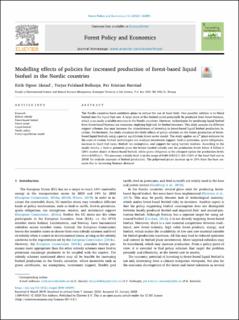Modelling effects of policies for increased production of forest-based liquid biofuel in the Nordic countries
Peer reviewed, Journal article
Published version
Permanent lenke
https://hdl.handle.net/11250/2984661Utgivelsesdato
2020Metadata
Vis full innførselSamlinger
Sammendrag
The Nordic countries have ambitious plans to reduce the use of fossil fuels. One possible solution is to blend biofuel into the liquid fuel mix. A large share of this biofuel could potentially be produced from forest biomass, which is an easily available resource in the Nordic countries. However, technologies for producing liquid biofuel from forest-based biomass are immature, implying high risk for biofuel investors. This study assesses six different support schemes that may increase the attractiveness of investing in forest-based liquid biofuel production facilities. Furthermore, the study simulates the likely effects of policy schemes on the future production of forestbased liquid biofuels using a partial equilibrium forest sector model. The study applies an nth plant estimate for the costs of various biofuel technologies and analyses investment support, feed-in premiums, quota obligations, increase in fossil fuel taxes, biofuel tax exemptions, and support for using harvest residues. According to the model results, a feed-in premium gives the lowest needed subsidy cost for production levels below 6 billion L (25% market share) of forest-based biofuel, while quota obligation is the cheapest option for production levels above 6 billion L. The necessary subsidy level is in the range of 0.60–0.85 €/L (82–116% of the fossil fuel cost in 2030) for realistic amounts of biofuel production. The pulpwood prices increase up to 24% from the base scenario due to increasing biomass demand.
